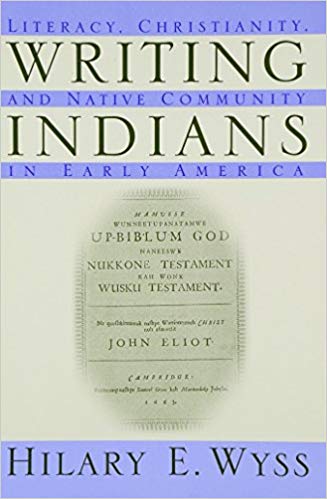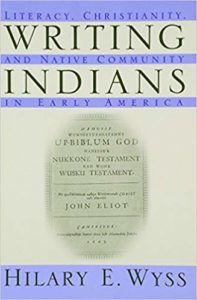Who’s A Real Indian?

Every year when I teach my course on early American literature, filled with salty travelers, solemn Puritans, nefarious tobacconists, and fiery Revolutionaries, I can count on at least one student asking, “But what did the Indians think?” Why, such students invariably go on to ask, aren’t the voices of the inhabitants who were all but eradicated by the colonists more fully represented on the syllabus? I imagine teachers of the very first course on early American literature faced the same questions, for it’s a problem that has dogged scholars in the field since the field began. We have usually answered by pointing out that almost no Native American cultures had writing, so, as much as we would like to include work by Indian authors in our reading lists and literary analyses, the written material does not exist. While this answer has the virtue of providing a response that satisfies most students, its accuracy depends on how we define a “real” Indian. For, as more and more scholars of early American studies are teaching us, there were, in fact, many writers of Native American descent before 1800, we have just generally chosen to ignore them. In Writing Indians: Literacy, Christianity, and Native Community in Early America, Hilary E. Wyss aims to show us why we do so at the expense of our understanding of both Native American and European American cultures.
To make her case, Wyss integrates insights gained from various fields of study, including anthropology, history, and literature, and she incorporates these insights into her story while at the same time producing a work that is accessible to any thoughtful reader, including those outside the comfy confines of the ivy tower. While wonderfully eclectic in its cannibalizing of various disciplines, literary studies serves as her specific scholarly target. Wyss contends that scholars of early American literature have let their notions of what constitutes an “‘authentic’ Native voice” (9) deafen them to the many writings by Christian Indians before William Apess’s work of the early nineteenth century. Wyss argues that a treasure trove of literary material will magically become available for our analyses once literary scholars stop insisting that only Natives untainted by the alien influences of colonial culture count as Native writers. These writers, she insists, can teach us a great deal about the various Native worldviews literary scholars have tended to mystify rather than analyze.
In order to prove her point as well as establish that “a tradition of Native American life writing . . . precedes Apess by almost 150 years” (4), Wyss analyzes writings from the late seventeenth to the early nineteenth centuries related to “five specific situations” involving Christianized Indians in the northeastern United States (14). First, she looks at documents by and about Christianized Indians in King Philip’s War in the late seventeenth century. From there, she considers the writings of and about Christianized Indians on Martha’s Vineyard in the early eighteenth century, concentrating on Experience Mayhew’s 1727 work Indian Converts. Chapters 3 and 4 consider the writings produced out of communities specifically formed with Native converts in mind, Stockbridge, Massachusetts, and Brotherton, New York, respectively. Her final chapter looks at how our understanding of Apess’s work would change if we considered his writings in the context of the larger tradition which she has just outlined.
Wyss proves her point to my satisfaction about the existence of a Native tradition of life writing before Apess. Each of her chapters taught me something about the need to pay closer attention to writings that remain relatively unexamined by scholars in my field–and, I dare say, by most people interested in early American literature and culture–as well as about what I might learn if I did, indeed, pay greater heed to these writings. Her discussion of the conversion narratives recorded by Experience Mayhew was extraordinarily provocative, for instance, and her analysis of the writings of the late-eighteenth century Native diplomat Hendrick Aupaumut exposes us to a relatively unknown figure while providing insightful readings of his work. Sometimes her analysis even touches directly on the reigning giants of colonial American literary study. So, for instance, her readings of the writings of Christianized Indians negotiating the exchange of Mary Rowlandson provide insights into Rowlandson’s captivity narrative like few others that have examined that work–and there have been many scholars, indeed, who have examined it.
Where many of Wyss’s readings are intriguing and she has brought to light many interesting issues and writers, her unwillingness to think more thoroughly about the implications of her own insights renders what she has taught us less persuasive and powerful than it might have been. So, for instance, in what I believe to be an extraordinarily astute move, Wyss cautions us against taking Native-ness, or, she says, Christian-ness, as having some essential purity (11). Instead of looking for writings that will speak from a position of pure identity, Wyss says she will examine how a piece of writing “help[s] define the cultural position of the Christian Indian” (11). In other words, writing rather than experience produces identity here. With this single gesture, Wyss calls into question the very foundation of literary studies as a record of the lived experience of particular individuals. In so doing, her project asks us to stop imagining literary works primarily as the records of different categories of people. Instead, the project she proposes would have us look at writing as part of the process that gives us the very categories we use to experience reality–categories like “Native” and “English” and “Protestant” and “Civilized.” Unfortunately, Wyss herself falls back on the very language of those critics who got us into the intellectual conundrum that blinded us to the value of Native writing in the first place. Namely, she casts her work as unearthing what can only be called the “authentic” “lived experience” (3) of her Native subjects. It seems to me that we cannot have it both ways–we cannot give up the notion of pure, essential identities at the same time we speak of writings that embody the “authentic lived experiences” of what amounts to some other allegedly “pure” category of identity.
The attempt to have it both ways with identity rears its ugly head again in the realm of history. For in spite of her largely laudatory efforts to be sensitive to the historical forces acting on the works she analyzes, the very concepts at issue here are themselves historical products, rather than essential categories that exist outside of time and place. Notions of race, nation, self, liberty, to name only a few of the abstract concepts Wyss uses to describe issues that motivate her subjects, are in flux during the period, and the writing Wyss points us toward may very well have been influential in producing the way we unthinkingly understand these concepts now. By using modernized notions of these concepts to analyze literary texts from before the nineteenth century, Wyss misses some of what these terms would have meant for their authors and, as a result, misleads her readers about the very terms of the debates she’s investigating.
I found the problems with Writing Indians particularly troubling, I suppose, because I learned so much from the book. I think Wyss has done an admirable job of providing an intriguing and readable introduction to an important subject, one which, she has convinced me, we will be hearing much more of in the future.
This article originally appeared in issue 2.3 (April, 2002).
Jim Egan teaches colonial British American literature at Brown University.
